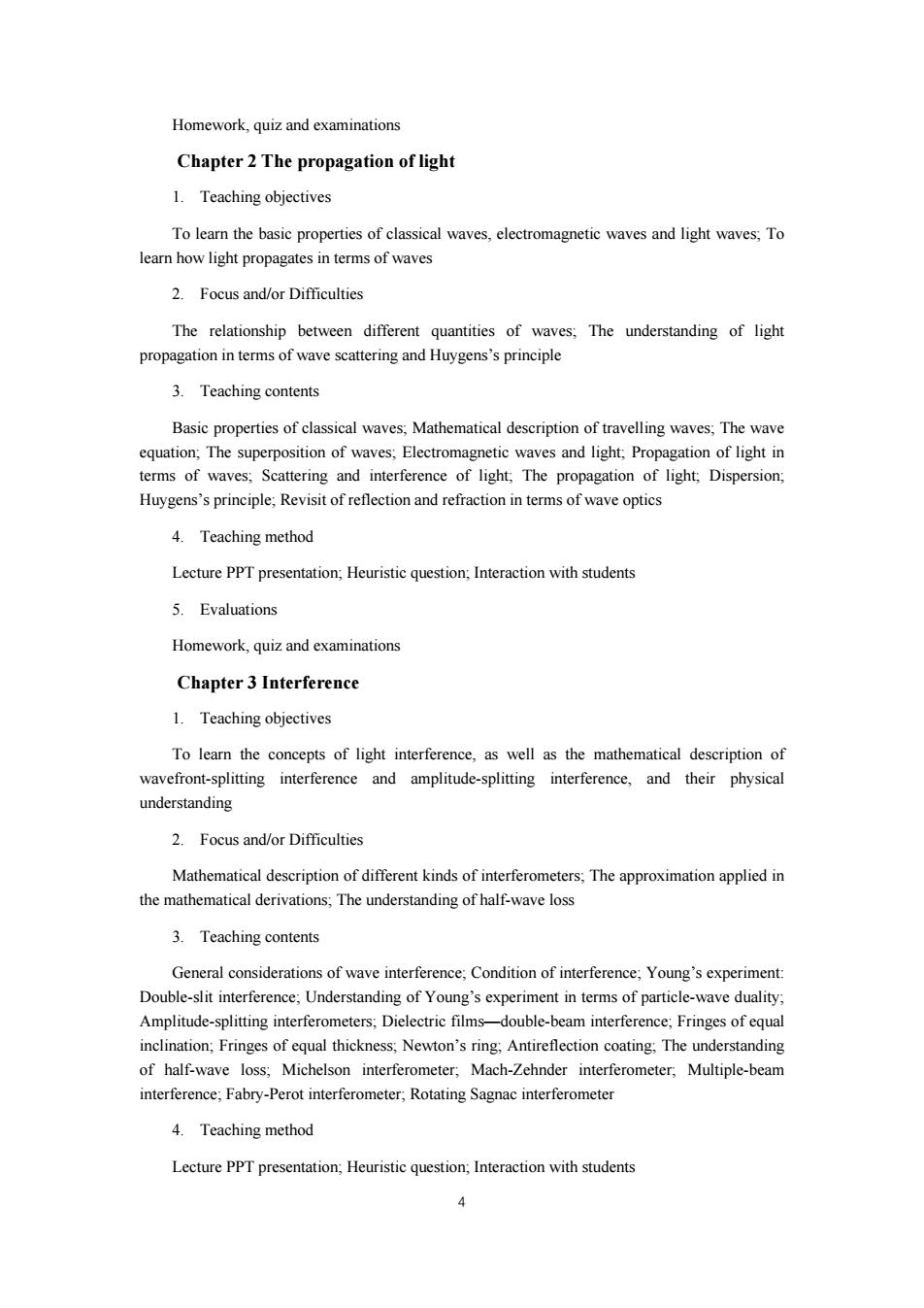正在加载图片...

Homework,quiz and examinations Chapter 2 The propagation of light 1.Teachingobjectives To learn the basic properties of classical waves,electromagnetic waves and light waves,To learn how light propagates in terms of waves 2.Focus and/or Difficulties The relationship between different quantities of waves,The understanding of light propagation in terms of wave scattering and Huygens's principle 3.Teaching contents Basic properties of waves,Mathematical description of travelling waves,The wave equation,The superposition of waves,Electromagnetic waves and light;Propagation of light in terms of waves,Scattering and interference of light;The propagation of light,Dispersion, Huygens's principle;Revisit of reflection and refraction in terms of wave optics 4.Teaching method Lecture PPT presentation,Heuristicquestion Interaction with students 5.Evaluations Homework,quiz and examinations Chapter 3 Interference 1.Teaching objectives To learn the concepts of light interference,as well as the mathematical description of wavefront-splitting interference and amplitude-splitting interference.and their physical understanding 2.Focus and/or Difficulties Mathematical description of different kinds of interferometers.The approximation applied in the mathematical derivations;The understanding of half-wave loss 3.Teaching contents General considerations of wave interference,Condition of interference.Young's experiment Double-slit interference.Understanding of Young's experiment in terms of particle-wave duality. Amplitude-splitting interferometers;Dielectric films-double-beam interference:Fringes of equal inclination:Fringes of equal thickness:Newton's ring:Antireflection coating:The understanding of half-wave loss:Michelson interferometer Mach-Zehnder inter ferometer,Multiple-beam interference;Fabry-Perot interferometer,Rotating Sagnac interferometer 4.Teaching method Lecture PPT presentation:Heuristic question:Interaction with students4 Homework, quiz and examinations Chapter 2 The propagation of light 1. Teaching objectives To learn the basic properties of classical waves, electromagnetic waves and light waves; To learn how light propagates in terms of waves 2. Focus and/or Difficulties The relationship between different quantities of waves; The understanding of light propagation in terms of wave scattering and Huygens’s principle 3. Teaching contents Basic properties of classical waves; Mathematical description of travelling waves; The wave equation; The superposition of waves; Electromagnetic waves and light; Propagation of light in terms of waves; Scattering and interference of light; The propagation of light; Dispersion; Huygens’s principle; Revisit of reflection and refraction in terms of wave optics 4. Teaching method Lecture PPT presentation; Heuristic question; Interaction with students 5. Evaluations Homework, quiz and examinations Chapter 3 Interference 1. Teaching objectives To learn the concepts of light interference, as well as the mathematical description of wavefront-splitting interference and amplitude-splitting interference, and their physical understanding 2. Focus and/or Difficulties Mathematical description of different kinds of interferometers; The approximation applied in the mathematical derivations; The understanding of half-wave loss 3. Teaching contents General considerations of wave interference; Condition of interference; Young’s experiment: Double-slit interference; Understanding of Young’s experiment in terms of particle-wave duality; Amplitude-splitting interferometers; Dielectric films—double-beam interference; Fringes of equal inclination; Fringes of equal thickness; Newton’s ring; Antireflection coating; The understanding of half-wave loss; Michelson interferometer; Mach-Zehnder interferometer; Multiple-beam interference; Fabry-Perot interferometer; Rotating Sagnac interferometer 4. Teaching method Lecture PPT presentation; Heuristic question; Interaction with students